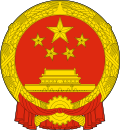District (China)
Counties ( Chinese 縣 / 县 , Pinyin Xiàn ) are administrative units in China at the lower level, the county level, comparable to a district or county in other states. There are currently 1442 counties (as of December 31, 2013) in the People's Republic of China . There are 14 rural districts and five urban districts or urban districts in the province of Taiwan or Republic of China . The main locations and thus the seat of the district administrations are usually large municipalities (in rare cases municipalities), which often already have a strongly urban character.
history
Counties are among the oldest administrative units in China; like the communities , they have been around since the Western Zhou Dynasty (1045–770 BC). With the unification of the empire in 221 BC Several districts were subordinated to a so-called "Kommandantur" ( 郡 , jùn ). At that time there were around 1000 districts in a total of 36 command offices. From the Sui dynasty (581–618), the districts were then subordinate to the prefectures ( 州 , zhōu ), but in principle this system was retained until the end of the imperial era. It was not until 1912, with the establishment of the Republic of China , that the counties were directly subordinate to the provinces; the prefectures, now called "district" in German, were also subordinate to the provincial government, with different responsibilities for road construction etc.
People's Republic of China
The structure from the time of the republic exists in principle to this day, even if some districts in the minority areas are subordinate to autonomous districts . On the one hand, this has personal consequences - the district administrator must always be of the ethnic group that exercises the autonomy rights. In addition, all public buildings, street signs and forms in the relevant districts must be bilingual, for example in Chinese and Yi in the districts of the Chuxiong Autonomous District of Yunnan Province . In addition, there are also autonomous counties ( 自治縣 / 自治县 , zìzhìxiàn ) within the autonomous districts for the minorities , such as the Weixi Autonomous District of the Burmese Lisu ethnic group in the Dêqên Autonomous District of the Tibetans in northwest Yunnan.
The number of counties on the mainland of the People's Republic of China should continue to shrink in the future, as counties are now and then converted into urban districts or urban districts. Districts are usually subordinate to the district level. In the direct government cities of Beijing , Tientsin , Shanghai and Chongqing as well as in the province of Hainan , however, they are directly subordinate to the provincial level, which here has refrained from installing a district level at all or expanding the district level to counties (Hainan).
The criterion for converting districts into urban districts or urban districts is in the first case the degree of urbanization in combination with a certain distance from the center of a district-free city, in the second case the actual or expected development of a merging of the urban center of the district to be dissolved with the / the central district / s of a prefecture-level city.
literature
- Sebastian Heilmann : Political System, 3rd People's Republic. In: Stefan Friedrich, Hans-Wilm Schütte, Brunhild Staiger (eds.) The great China Lexicon. History, geography, society, politics, economy, education, science, culture. Wissenschaftliche Buchgesellschaft, Darmstadt 2003, ISBN 3-534-14988-2 , pp. 575-578.
- Erling von Mende , Heike Holbig: Local administration. In: Stefan Friedrich, Hans-Wilm Schütte, Brunhild Staiger (eds.) The great China Lexicon. History, geography, society, politics, economy, education, science, culture. Wissenschaftliche Buchgesellschaft, Darmstadt 2003, ISBN 3-534-14988-2 , pp. 456–458.
- Meyer's Atlas China. On the way to world power. Bibliographisches Institut AG, Mannheim 2010, ISBN 978-3-411-08281-0 , pp. 92-93.
- Yin Zhongqing (尹中卿): The political system in China today. China Intercontinental Press, Beijing 2004, ISBN 7-5085-0470-4 .
Individual evidence
- ↑ 罗 竹 风 (主编) :汉语大词典.第九卷. 汉语大词典 出版社, 上海 1994 (第二 次 印刷), p. 963.
- ^ Charles O. Hucker: A Dictionary of Official Titles in Imperial China. Stanford University Press , Stanford 1985, p. 240.
- ↑ At village level , this is not a must, but a should (应当): http://www.china.org.cn/english/government/207279.htm Article 9.
